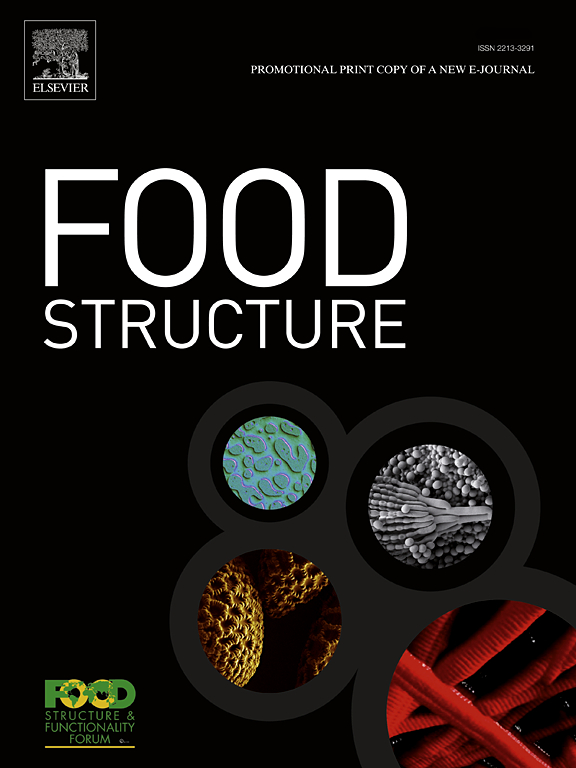旋转傅里叶变换(RFT)可以量化高水分植物蛋白挤出物的各向异性结构
IF 5.9
3区 农林科学
Q1 FOOD SCIENCE & TECHNOLOGY
引用次数: 0
摘要
当通过高水分挤压(HME)生产基于植物蛋白的肉类类似物时,挤出物的结构由成分组成和加工条件之间的复杂相互作用决定。通过使用MRI或共聚焦显微镜对样品进行成像,可以深入了解结构过程。然而,现有的分析这些图像的软件为定量分析结构和各向异性提供了有限的选择。在这里,我们提出了一种新的图像处理方法,旋转傅里叶变换(RFT),可以量化挤出物的各向异性结构。RFT提供了一种单一的、与空间相关的结构各向异性度量,即加权顺序参数(WOP)。RFT使用傅里叶变换来获得表示图像中检测到的结构方向的主导角。通过计算每个角度的幅值作为加权因子,有效地滤除了噪声,提高了信噪比。特别地,我们应用RFT来量化大豆浓缩蛋白HME样品的结构各向异性。我们使用微米分辨率的磁共振成像(MRI)显示,在中性pH下制备的样品比在酸性pH下制备的样品具有更高的结构各向异性。使用亚微米分辨率的共聚焦激光扫描显微镜(CLSM),我们沿着冷却模具对样品进行了从皮肤到核心区域的成像,并显示各向异性向皮肤增加。我们注意到RFT是一种通用的方法,适用于任何显示各向异性特征的图像。因此,RFT是对食物结构及其他方面进行全面量化的有力工具。本文章由计算机程序翻译,如有差异,请以英文原文为准。
Rotated Fourier transform (RFT) enables the quantification of anisotropic structure in high-moisture plant-protein extrudates
When producing plant-protein-based meat analogues via high moisture extrusion (HME), the structure of extrudates is determined by complex interactions between ingredient composition and processing conditions. Insights into the structuring process can be gained by imaging samples using MRI or confocal microscopy. However, existing software for analysing these images provide limited options for quantitatively analysing both structure and anisotropy. Here, we present a novel image processing method, Rotated Fourier Transform (RFT), that enables the quantification of anisotropic structures of extrudates. RFT provides a single, spatial dependent measure of structural anisotropy, namely the weighted order parameter (WOP). RFT uses Fourier transforms to obtain the dominant angles representing the structural orientation detected within the image. By calculating an amplitude per angle as the weighing factor, noise is effectively filtered and improved signal-to-noise ratios can be obtained. In particular, we applied RFT to quantify structural anisotropy of soy protein concentrate HME samples. We employed magnetic resonance imaging (MRI) at micrometer resolution to show that samples prepared at neutral pH feature higher structural anisotropy than samples prepared at acidic pH. Using confocal laser scanning microscopy (CLSM) at sub-micrometer resolution, we imaged samples from the skin to the core region along the cooling die and show that the anisotropy increases towards the skin. We note that RFT is a generic method applicable to any image displaying anisotropic features. Thus, RFT is a powerful tool for the comprehensive quantification of food structures and beyond.
求助全文
通过发布文献求助,成功后即可免费获取论文全文。
去求助
来源期刊

Food Structure-Netherlands
Chemical Engineering-Bioengineering
CiteScore
7.20
自引率
0.00%
发文量
48
期刊介绍:
Food Structure is the premier international forum devoted to the publication of high-quality original research on food structure. The focus of this journal is on food structure in the context of its relationship with molecular composition, processing and macroscopic properties (e.g., shelf stability, sensory properties, etc.). Manuscripts that only report qualitative findings and micrographs and that lack sound hypothesis-driven, quantitative structure-function research are not accepted. Significance of the research findings for the food science community and/or industry must also be highlighted.
 求助内容:
求助内容: 应助结果提醒方式:
应助结果提醒方式:


